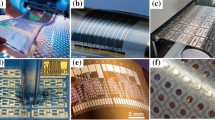Abstract
The focus of this study is on the development of a mathematical model for estimating tension of a printing section by using the register error in R2R (Roll to Roll) e-Printing systems. In a printing section of conventional R2R printing systems, the tension is generally measured not for controlling but for monitoring, because the tension control may cause the occurrence of a register error. But, for high precision control, the tension in the R2R e-Printing system must be controlled as well as measured for more precise control of the register error. The tension can be measured by the loadcell in the conventional R2R systems. However, installing a loadcell on the R2R systems causes extra economic burden. In addition, the space for adding a loadcell on R2R systems is limited due to many components including dryers, lateral guider, doctor blade, ink supply unit and cooling unit. Therefore, a tension estimator can be another possibility for predicting the tension in a printing section. In this study, a new tension estimation model is proposed. The proposed model is based on the register error model, the equivalent torque equation, and the tension model considering tension transfer. Numerical simulations and experimental results showed that the proposed model was effective in estimating the tension in a printing section.
Similar content being viewed by others
References
G. Brandenburg, New mathematical models for web tension and register error, Proc. 1. 3rd International IFAC Conf. on Instrumentation and Automation in the paper, Rubber and Plastics Industries, Brussels, May 24–26 (1976).
K. H. Shin, Tension Control, Technology Park/Atlanta, Tappi Press (2000).
W. Wolfermann, Sensorless Tension Control of Webs, Proceedings of the fourth International Conference on Web Handling IWEB, Stillwater, Oklahoma (1997).
J. Ruiz C, D. Sbarbaro, Estimating the Strip Tension in Multi-Drive Systems, Proceedings of the 23rd International Conference on Industrial Electronics, Control and Instrumentation (1997).
S. H. Song and S. K. Sul, A New Tension Controller for Continuous Strip Processing Line, IEEE Industrial Application. Conference (1998).
K. C. Lin, Observer-Based Tension Feedback Control With Friction and Inertia Compensation, A Transaction on Control Systems technology (2003).
A. F. Lynch, S. A. Bortoff and K. R. benack, ’Nonlinear tension observers for web machines, Automatica, 40 (2004).
C. F. Puckhaber, Print registration control in a rotogravure printing press combined with extrusion, coating or lamination process, Tappi journal (1995).
H. L. Weiss, Rotogravure and Flexographic Printing Presses, Converting Technology Corp. (1985).
Author information
Authors and Affiliations
Corresponding author
Additional information
This paper was recommended for publication in revised form by Associate Editor Hong Hee Yoo
Chang-Woo Lee received a B.S. degree in Mechanical Engineering from Konkuk University in 2001. He received his M.S. and Ph.D. degrees from Konkuk university in 2003 and 2008, respectively. Dr. Lee is currently a researcher at the Flexible Display Roll to Roll Research Center at Konkuk University in Seoul, Korea. Dr. Lee’s research interests are in the area of fault tolerant control, R2R e-Printing line design, and tension-register control. He is the holder of several patents related to R2R e-Printing system.
Jang-Won Lee received the B.S. and M.S.degrees in mechanical engineering from Konkuk University, Seoul, Korea. He studied continuous flexible process at the FDRC (Flexible Display R2R Research Center, Project Director: Kee-Hyun Shin), as a reseacher from the concentment to 2008. Since 2008, he has been a Research Engineer with the SKC Films R&D, Suwon, Gyeonggi-do, Korea. Now he is great on the plastic flim mechanics such as a scratch on the film surface, film extruding, winding/slitting mecha-nism and coating processes.
Hyunkyoo Kang received the B.S. and M.S degree in 2000 and 2003 res-pectively from Konkuk Uni-versity, Seoul, Korea, where he is currently working toward the Ph. D. degree in mechanical design. He took part in the development of an autoalign guiding system for high-speed winding in a cable winding system, a 3-D roll-shape diagnosis method in a steel rolling system, a design of register controller for high-speed converting machine and real-time control design of electronic printing machine. His research topics include register modeling and control for printed electronics and distributed real-time control.
Kee-Hyun Shin received the B.S. degree from Seoul National University, Seoul, Korea, and the M.S. and Ph.D. degrees in mechanical engineering from Oklahoma State University (OSU), Stillwater. Since 1992, he has been a Professor with the Department of Mechanical and Aerospace Engineering, Konkuk University, Seoul, Korea. For more than 18 years, he has covered several research topics in the area of web handling, including tension control, lateral dynamics, diagnosis of defect rolls/rollers, and fault-tolerant realtime control in the Flexible Display Roll-to-Roll Research Center, Konkuk University, of which he has also been a Director. He is the author of Tension Control (TAPPI Press, 2000) and is the holder of several patents related to R2R e-Printing system.
Rights and permissions
About this article
Cite this article
Lee, C., Lee, J., Kang, H. et al. A study on the tension estimator by using register error in a printing section of roll to roll e-printing systems. J Mech Sci Technol 23, 212–220 (2009). https://doi.org/10.1007/s12206-008-0927-2
Received:
Revised:
Accepted:
Published:
Issue Date:
DOI: https://doi.org/10.1007/s12206-008-0927-2



